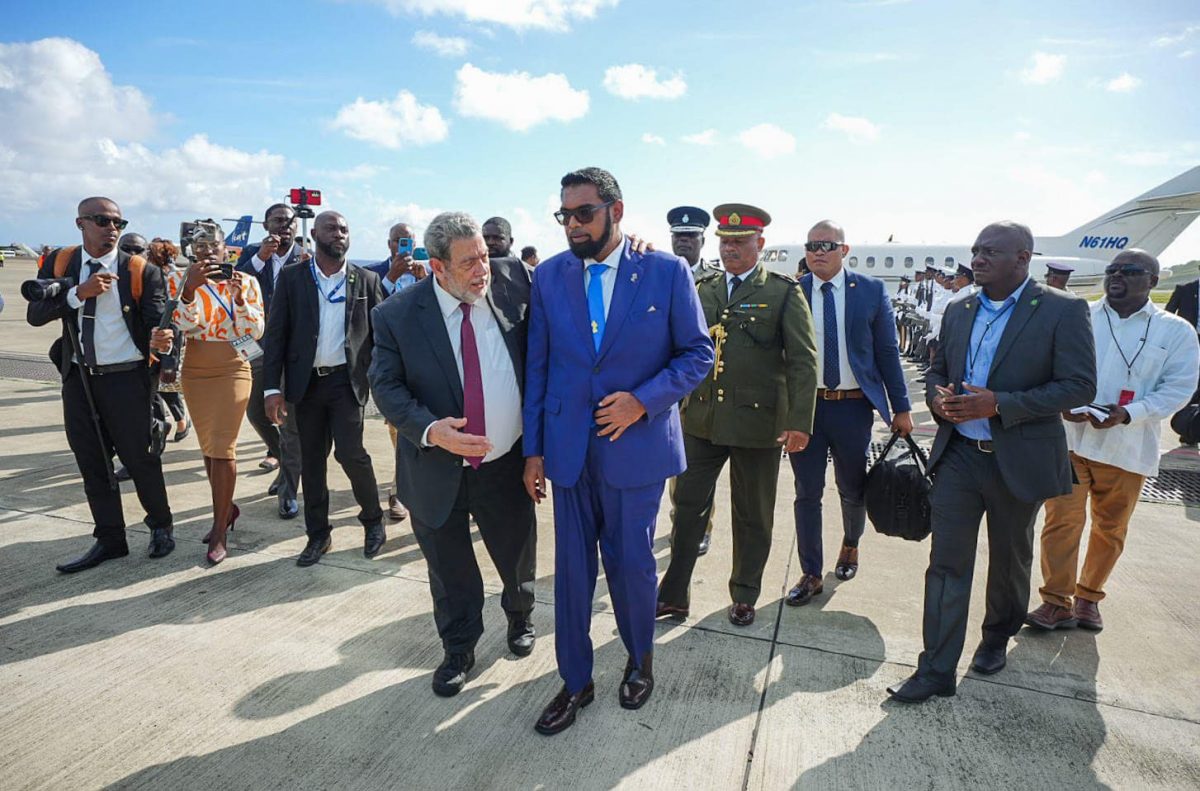St Vincent and the Grenadines Prime Minister, Ralph Gonsalves yesterday said that he was unaware that in December 2022 he had been standing behind a papier-mâché map of Venezuela which included Guyana’s county of Essequibo.
The appearance on social media of the image triggered queries of Gonsalves by the Guyana Government given the interlocutor role he played last month in trying to ease tensions between this country and Venezuela which spiralled after Caracas staged a referendum to annexe Essequibo.
In a letter of yesterday’s date addressed to President Irfaan Ali and President Nicolas Maduro of Venezuela, Gonsalves urged that the two leaders build on the December 14 Declaration of Argyle setting out the pathway to de-escalate tensions between the two countries.
Gonsalves explained the circumstances surrounding his appearance in proximity to the false papier-mâché map of Venezuela. He said that the photograph was taken at the commemoration of the life and work of the great Liberator Simon Bolivar on the grounds of the residence/office of the Chargé d’Affaires of Venezuela to St Vincent at a location called Villa.
“I do not recall ever seeing this photograph before its current circulation. I am informed that photographs were being taken in front of flags of St Vincent and the Grenadines and Venezuela and a bust of Bolivar. While the photographs were being taken, I am advised that someone attached to the Venezuelan Embassy placed the “papier-mâché” depiction of the said map in front of us. I did not look at what the depiction was. I assumed that was about Simon Bolivar”, he wrote.
His account of what happened underlines concerns that have grown here about the aggressive efforts by Venezuela in recent months to parade the incorrect map even in member states of CARICOM which have vociferously defended Guyana’s internationally recognised borders and territorial integrity. Analysts say the papier-mâché flap also underscores the deviousness of Venezuelan diplomatic personnel in the manner in which the map was placed before Gonsalves.
The St Vincent PM said that it was unfortunate that this “innocent inadvertence on my part” has been used by some to stir up antipathy of one type or another.
“I understand all the emotions attendant on this controversial issue; and from time-to-time there will be flare-ups. As always, though, we as leaders must maintain a patience and a calm knowing that sun brightens stone, even as the river burns”, he said.
He cited the `Joint Declaration at Argyle for Dialogue and Peace Between Guyana and Venezuela’ for the two leaders to apply and build upon.
Noting that he had spoken to his friends, President Ali and Vice President Bharrat Jagdeo about the matter, he said that hopefully it has been laid to rest “where it ought properly to reside among the assorted ghosts from the past, which ought to never to rule us from the grave”.
He added that he was profoundly encouraged by the January 2nd letter by President Ali to President Maduro In relation to arranging the first meeting of the Joint Commission in Brasilia to advance the Argyle Declaration and its purposes.
In the Argyle Declaration, among other things, Guyana and Venezuela:
1. Agreed that Guyana and Venezuela, directly or indirectly, will not threaten or use force against one another in any circumstances, including those consequential to any existing controversies between the two States.
2. Agreed that any controversies between the two States will be resolved in accordance with international law, including the Geneva Agreement dated February 17, 1966.
3. Committed to the pursuance of good neighborliness, peaceful coexistence, and the unity of Latin America and the Caribbean.
4. Noted Guyana’s assertion that it is committed to the process and procedures of the International Court of Justice for the resolution of the border controversy. Noted Venezuela’s assertion of its lack of consent and lack of recognition of the International Court of Justice and its jurisdiction in the border controversy
5. Agreed to continue dialogue on any other pending matters of mutual importance to the two countries.
6. Agreed that both States will refrain, whether by words or deeds, from escalating any conflict or disagreement arising from any controversy between them. The two States will cooperate to avoid incidents on the ground conducive to tension between them. In the event of such an incident the two States will immediately communicate with one another, the Caribbean Community (CARICOM), the Community of Latin America and the Caribbean (CELAC), and the President of Brazil to contain, reverse and prevent its recurrence.
7. Agreed to establish immediately a joint commission of the Foreign Ministers and technical persons from the two States to address matters as mutually agreed. An update from this joint commission will be submitted to the Presidents of Guyana and Venezuela within three months.
Days after the Argyle Declaration, Venezuela complained about the visit here of a UK Navy ship.






